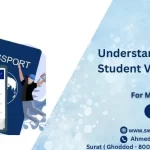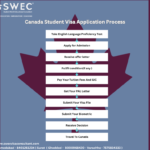Australia’s Vocational Education and Training (VET) system is a popular pathway for students who want to develop practical skills in specific industries. Unlike traditional university programs, VET courses focus more on hands-on experience and industry-based learning, helping students acquire job-ready skills that can immediately be applied in the workforce. VET covers a wide range of fields including trades, business, hospitality, IT, healthcare, and more. The VET system is especially attractive to international students who aim to build expertise and enter the global workforce quickly.
This blog is designed to give you a detailed, step-by-step guide on how to apply for a VET Student Visa in Australia. From eligibility criteria to the application process, this blog will provide all the essential information you need to successfully navigate the visa process and start your vocational education journey in Australia.
Table of Contents
What is a VET Student Visa?
A VET Student Visa (subclass 500) allows international students to study full-time in an accredited vocational education and training course in Australia. This visa permits students to stay in Australia for the duration of their course, with the option to work part-time during studies and full-time during breaks, making it an attractive option for those who want to earn while they learn.
The Importance of VET for International Students
International students flock to Australia for VET courses because of the system’s strong focus on providing industry-relevant skills, offering multiple qualification levels from certificates to diplomas and advanced diplomas. These qualifications can open doors to various career opportunities, both in Australia and globally. Additionally, VET can be a stepping stone for students who wish to pursue higher education or migrate to Australia through skilled migration pathways.
What is Vocational Education and Training (VET)?
Vocational Education and Training (VET) is a system of education that equips students with practical skills and qualifications for specific industries and occupations. Unlike more theoretical university programs, VET focuses on preparing students for the workforce through hands-on training. This system is highly flexible and includes courses that range from basic skill acquisition to advanced technical skills.
How VET Differs from University Education
VET courses are typically shorter and more affordable than university degrees. The focus is on immediate job readiness rather than academic research or theoretical learning. VET qualifications are practical and vocational, designed to meet the needs of various industries. In contrast, university education tends to emphasize knowledge and academic skills suited for professions requiring deeper theoretical understanding, such as engineering, medicine, or law.
Popular Industries and Qualifications Offered Under VET
VET qualifications cater to a wide variety of industries. Some of the most popular sectors include:
- Trades: Automotive, construction, electrical work, plumbing.
- Hospitality and Tourism: Hotel management, cooking, event management.
- Information Technology (IT): Software development, network security, web design.
- Health Care: Aged care, nursing, medical assistant programs.
- Business and Management: Marketing, project management, human resources.
VET courses offer qualifications ranging from Certificates I-IV, Diplomas, and Advanced Diplomas. These qualifications are recognized nationally and internationally, giving students a competitive edge in the job market.
Benefits of Studying VET in Australia
- High Employability Rate: VET courses are designed in collaboration with industry experts to ensure that students graduate with the skills that employers are actively seeking.
- Flexible Learning Paths: VET offers various entry points and pathways. Students can start with a certificate course and progress to a diploma, or even use their VET qualifications to gain credits towards university programs.
- Pathway to Further Education or Employment: VET can serve as a foundation for students who wish to continue their education or gain work experience in Australia. VET graduates can also apply for post-study work visas or pursue skilled migration if they meet the necessary criteria.
Eligibility Criteria for a VET Student Visa
Confirmation of Enrolment (CoE) Requirement
To apply for a VET Student Visa (subclass 500), you must first secure admission into a registered Australian vocational education provider. Once accepted, the institution will issue a Confirmation of Enrolment (CoE). This document is a mandatory requirement for the visa application process and serves as proof that you have been admitted to a registered course. Ensure that the provider is listed on the CRICOS (Commonwealth Register of Institutions and Courses for Overseas Students).
English Language Proficiency
International students are required to demonstrate their English language skills to ensure they can cope with the demands of their VET course. The most commonly accepted English language tests are:
- IELTS (International English Language Testing System)
- TOEFL (Test of English as a Foreign Language)
- PTE Academic (Pearson Test of English)
Minimum score requirements vary depending on the course and institution. Some students may be exempt from this requirement if they are from an English-speaking country or have completed a certain level of education in English.
Exemptions from English Language Requirements
Certain students may be exempt from providing English test scores. These exemptions include:
- Students from English-speaking countries.
- Those who have completed at least five years of study in an English-medium institution.
- Students who are applying for a visa based on enrollment in specific preparatory or foundation courses.
Financial Capacity
Australia requires international students to show proof of sufficient funds to cover tuition fees, living expenses, and travel costs. As of 2024, the minimum financial requirement is approximately AUD 29,710 per year for living expenses, excluding tuition fees. Applicants must provide documents such as bank statements, scholarship offers, or evidence of financial support from a sponsor.
Health and Character Requirements
International students must meet specific health and character criteria to ensure they are fit to live and study in Australia. These requirements include:
- Overseas Student Health Cover (OSHC): All international students must purchase OSHC for the entire duration of their stay. This insurance helps cover medical costs such as hospital care and doctor consultations.
- Character Check: Applicants must provide police certificates to show that they have no criminal record. This is part of the Australian government’s commitment to ensuring the safety of its residents.
- Health Examination: Depending on your country of origin and the length of your stay, you may need to undergo a health examination to prove that you meet Australian health standards.
Genuine Temporary Entrant (GTE) Requirement
The Genuine Temporary Entrant (GTE) requirement ensures that applicants intend to study in Australia temporarily and will return to their home country after completing their studies. To satisfy the GTE requirement, students must submit a written statement addressing factors such as:
- Why did they choose Australia over other countries for their studies?
- How their course aligns with their academic and career goals.
- Proof of ties to their home country that will motivate their return (e.g., family, employment, financial assets).
A well-prepared GTE statement can significantly improve your chances of obtaining a VET student visa, so it’s essential to be honest, clear, and detailed.
Step-by-Step Guide to Apply for a VET Student Visa
Step 1: Select a Registered VET Course and Provider
Before applying for a VET student visa, you must choose a vocational course from a registered provider. The course and provider must be registered under CRICOS (Commonwealth Register of Institutions and Courses for Overseas Students) to ensure that your qualification will be recognized in Australia. When selecting a VET course, consider the following:
- Alignment with Career Goals: Ensure the course you choose provides the skills needed for your desired industry.
- Course Duration and Costs: Check the length and fees associated with the course to determine if it meets your financial plan and time commitment.
Step 2: Gather Required Documents
Once you’ve chosen your course, gathering the necessary documents for your visa application is crucial. Here’s what you will need:
- Confirmation of Enrolment (CoE): Provided by your education institution once you are accepted into the VET course.
- Passport Copy: A clear, valid copy of your passport.
- English Language Proficiency Test Results: Accepted tests include IELTS, TOEFL, or PTE.
- Financial Evidence: Proof that you have enough funds to cover tuition, living expenses, and return travel costs. Bank statements or approved loans are usually accepted.
- Overseas Student Health Cover (OSHC): Proof that you have purchased health insurance for the duration of your stay.
- Genuine Temporary Entrant (GTE) Statement: A written statement explaining your reasons for studying in Australia and your plans to return home after your studies.
- Police Clearance Certificate (if required): You may need to provide proof of good character, depending on your country of origin.
Step 3: Create an ImmiAccount
To submit your application online, you need to create an ImmiAccount through the Australian Department of Home Affairs website. Here’s why it’s important:
- Track Your Application: Your ImmiAccount allows you to monitor the progress of your application, receive notifications, and upload documents.
- Apply Online: It serves as the platform for submitting your VET student visa application electronically.
Step 4: Submit the Visa Application
Once your documents are ready, follow these steps to submit your visa application:
- Form 157A: This is the application form for a student visa (subclass 500). Make sure all the details are accurate and up-to-date.
- Upload Documents: Scan and upload your documents, including CoE, English proficiency test results, and financial evidence.
- Pay the Application Fee: The standard application fee is AUD$1,600 (subject to change). You may also need to pay additional fees for biometric processing if required.
Step 5: Attend a Health Examination (If Required)
Depending on your country of residence and personal circumstances, you may be required to undergo a health examination. Here’s how to proceed:
- Book via the eMedical System: You can book your medical exam through the Australian eMedical system.
- What to Expect: The health examination will generally include a general physical check-up, X-rays, and blood tests, depending on the requirements set by the Department of Home Affairs.
Step 6: Await Visa Outcome
After submitting your application, you’ll need to wait for a decision:
- Average Processing Time: VET student visas can take anywhere from 4 to 12 weeks to process, depending on individual circumstances.
- Tracking: You can check the status of your visa through your ImmiAccount.
- Additional Information Requests: If the Department of Home Affairs requests more information or documents, ensure that you respond promptly to avoid delays.
Costs Associated with a VET Student Visa
Visa Application Fee
The visa application fee is a significant part of the costs of studying in Australia. As of 2024, the standard application fee for a VET Student Visa (subclass 500) is AUD$1,600. However, this can vary based on factors like biometric processing or additional applicants (family members). It is always wise to check the latest fee schedule on the Department of Home Affairs website before applying.
Tuition Fees for VET Courses
Tuition fees for VET courses in Australia vary widely depending on the course, duration, and institution. Here’s a general breakdown:
- Certificates and Diplomas: Tuition fees for VET courses typically range from AUD 4,000 to AUD 22,000 per year.
- Some higher-level diplomas may have higher costs, depending on the industry and institution.
Health Insurance Costs (OSHC)
Overseas Student Health Cover (OSHC) is mandatory for all international students. This insurance covers medical and hospital care costs during your stay. The costs of OSHC depend on the provider and the length of your course, but a single student can expect to pay:
- AUD 450 to AUD 600 per year for basic coverage. OSHC must be purchased before applying for your visa, and the entire duration of coverage must match your visa term.
Living Expenses in Australia
In addition to tuition fees, international students must show that they can cover their living expenses while in Australia. The Department of Home Affairs recommends having at least:
- AUD 29,710 per year for living costs, excluding tuition and travel. This amount will cover accommodation, food, transport, and other daily expenses.
Understanding Visa Conditions
Work Rights for VET Students
While studying on a VET student visa, you are allowed to work part-time. The current regulations allow:
- Up to 40 hours per fortnight during study periods.
- Unlimited hours during official course breaks. Working while studying can help students manage their expenses, but it’s important to maintain a balance between work and study to ensure academic success.
Attendance and Academic Progress Requirements
As a VET student, you are required to maintain satisfactory attendance and academic performance. If you fail to meet these conditions, your visa may be at risk of cancellation. Institutions monitor student progress, and failure to attend classes or achieve passing grades can have serious consequences.
Changing Courses or Providers
If you wish to change your VET course or provider, you must adhere to the conditions set by the Department of Home Affairs. Here’s what you need to know:
- Study with the Same Provider for 6 Months: You must stay with your initial education provider for at least 6 months before transferring.
- Apply for a New CoE: If you change courses, you’ll need a new Confirmation of Enrolment (CoE).
Obligations to Maintain Health Insurance
It is a requirement to maintain valid Overseas Student Health Cover (OSHC) throughout your stay in Australia. Failure to do so may lead to visa cancellation. Ensure that your OSHC policy is up-to-date and covers the entire duration of your stay.
What to Do After Your Visa is Granted
Preparing to Move to Australia
Once your VET student visa is approved, the next step is to prepare for your journey. Creating a comprehensive pre-departure checklist can make the transition smoother:
- Flights: Book your flight tickets well in advance to get the best deals.
- Accommodation: Secure your accommodation in Australia, whether it’s on-campus, shared housing, or a rental.
- Banking: Open an international student bank account online to facilitate your finances once you arrive in Australia.
- Insurance: Ensure that your Overseas Student Health Cover (OSHC) is valid and you have all necessary medical documents.
Arriving in Australia: What to Expect
Upon arriving in Australia, several immediate steps need to be taken:
- Student ID: Obtain your student ID from your educational institution. This will give you access to various campus facilities.
- Orientation: Attend orientation sessions conducted by your VET provider. This will help you familiarize yourself with the campus, student services, and other international students.
- Local SIM and Banking Setup: Purchase a local SIM card for communication and activate your bank account for managing day-to-day expenses.
Support Services for International VET Students
Australia offers a wide array of support services for international students, ensuring a smooth transition into the education system and local life:
- Education Provider Support: Most VET providers offer counselling services, academic support, and career guidance.
- Government Support: The Australian Government assists through platforms like Study Australia and Toll-free hotlines for international students.
- Student Associations: Join student associations or clubs that align with your interests or cultural background to help with social integration.
Common Mistakes to Avoid When Applying for a VET Student Visa
Inadequate Financial Proof
One of the most common reasons for visa rejection is insufficient financial evidence. Make sure you:
- Provide accurate financial proof: You need to show proof that you can cover your tuition fees, living expenses, and return travel.
- Check the latest financial requirements: As of 2024, students are required to have access to at least AUD 29,710 annually for living expenses. This figure can vary, so ensure you meet the current requirements.
Submitting Incorrect or Incomplete Documentation
Failure to submit complete and accurate documents can delay or even result in visa rejection. Always:
- Double-check your documents: Ensure that all required documents, such as your Confirmation of Enrolment (CoE), passport copy, financial statements, and health insurance, are up to date and correctly submitted.
- Upload clear, readable copies: Poor-quality scans or missing pages can lead to delays.
Not Meeting the Genuine Temporary Entrant (GTE) Requirement
The GTE requirement is a key part of the visa application process. Common mistakes include:
- Writing a vague GTE statement: Make sure your GTE clearly outlines your study and career goals and why you plan to return to your home country after completing your education.
- Avoid generic responses: Tailor your GTE to your circumstances and future aspirations.
Delaying the Application
Procrastinating your application submission can put your visa at risk, especially if classes are about to begin. To avoid issues:
- Apply early: Start your visa process as soon as you receive your CoE to allow for any unexpected delays in processing.
What to Do if Your VET Student Visa is Rejected
Common Reasons for Visa Rejections
Visa rejections are typically caused by a few common issues:
- Incomplete or Incorrect Documentation: Missing documents or mistakes in your application form can lead to rejection.
- Insufficient Financial Proof: If you fail to demonstrate enough funds for your studies and living expenses, your application may be rejected.
- Unmet Health or Character Requirements: Not providing adequate health insurance or failing the character test (e.g., lack of police clearance) can lead to visa refusal.
Reapplying After Rejection
If your visa is rejected, it’s not the end of the road. You can reapply by:
- Correcting the issues: Identify the reason for rejection and ensure that you rectify the problems in your next application.
- Gathering new evidence: If financial capacity was an issue, submit updated bank statements or loan approvals to support your reapplication.
Appealing the Decision
In some cases, you may have grounds to appeal a visa rejection through the Administrative Appeals Tribunal (AAT). The process includes:
- Filing an appeal: You must file an appeal within a set timeframe (typically 21 days from the visa decision).
- Providing additional evidence: Present any new evidence that may help your case, such as corrected documents or updated financial proof.
Seeking Professional Assistance
If you’re unsure about reapplying or appealing, it may be beneficial to seek professional help:
- Migration Agents: Registered migration agents are experts in handling visa issues and can guide you through the reapplication or appeal process.
- Legal Experts: In cases of complex rejections, consulting with a lawyer specializing in immigration law might be necessary.
Pathways After Completing Your VET Course
Post-Study Work Visa Options
After completing your VET course, you may want to gain valuable work experience in Australia. One of the most popular options for international students is the Temporary Graduate Visa (subclass 485). This visa allows you to:
- Work in Australia temporarily: Depending on your qualifications, the visa can last between 18 months and 4 years.
- Eligibility for subclass 485: You must have completed a course that is at least 2 years in duration. It is also important to apply within six months of completing your course.
- How to apply: Submit the visa application through ImmiAccount, along with necessary documents like your qualification evidence and English language proficiency results (if required).
Skilled Migration Pathway
If you wish to stay in Australia long-term, the General Skilled Migration (GSM) program offers a pathway to permanent residency for skilled workers:
- Skilled Occupation List (SOL): Check if your VET qualification aligns with occupations listed on Australia’s SOL. Many VET graduates in industries like trades, IT, and healthcare may qualify.
- Points Test: To apply for a skilled migration visa, such as the Skilled Independent Visa (subclass 189) or Skilled Nominated Visa (subclass 190), you will need to pass a points test based on factors like age, qualification, work experience, and English proficiency.
- State Sponsorship: Some Australian states offer sponsorship for VET graduates under the Skilled Nominated Visa (subclass 190), which can increase your chances of obtaining permanent residency.
Further Education Options
VET courses also provide a strong foundation for continuing your education. After completing your VET qualification, you may decide to:
- Pursue Higher Education: Many VET graduates choose to continue their studies at the university level. VET qualifications can provide credits toward a bachelor’s degree, making it easier to transition to higher education.
- Apply for Advanced Diplomas or Certificates: If you’re looking to specialize further in your field, consider advancing your qualifications with a higher-level VET course, such as an Advanced Diploma or a specialized certification.
Final Tips for a Successful VET Student Visa Application
Applying for a VET student visa can be a smooth process if you:
- Prepare early: Ensure that all necessary documents, such as your Confirmation of Enrolment (CoE), financial evidence, and health insurance, are ready well in advance of submitting your application.
- Meet eligibility criteria: Double-check that you meet all visa requirements, including financial capacity, English language proficiency, and health/character standards.
- Be thorough with your GTE statement: The Genuine Temporary Entrant requirement is critical, so make sure your GTE statement reflects your intent to study and return to your home country.
Staying Updated on Visa Policies
Australia’s immigration and visa policies are subject to change, so it’s crucial to:
- Stay informed: Regularly check for updates on visa conditions, eligibility criteria, and policy changes from the Department of Home Affairs website. This will ensure you don’t miss any important updates that could affect your visa status.
- Adapt to new requirements: If policy changes occur, be prepared to adjust your plans and applications accordingly.
If you need expert assistance with your VET student visa application or post-study work options, it’s always a good idea to seek guidance. Consult SWEC’s professional visa and immigration experts for personalized advice and assistance tailored to your needs, ensuring a smooth and successful journey to Australia.
Frequently Asked Questions on VET Student Visa in Australia
Q1. What is vocational and education training (VET) in Australia?
Ans1. Vocational Education and Training (VET) in Australia focuses on practical skills and hands-on learning for various industries, such as trades, hospitality, IT, and healthcare. It aims to prepare students for specific jobs or further education through nationally recognized qualifications.
Q2. What is the VET course visa in Australia?
Ans2. The VET course visa in Australia is the VET Student Visa (subclass 500). This visa allows international students to enrol in a registered vocational education and training course at an Australian educational institution.
Q3. Can international students study vocational courses in Australia?
Ans3. Yes, international students can study vocational courses in Australia by applying for a VET Student Visa (subclass 500). This visa enables students to undertake various vocational qualifications, such as certificates, diplomas, and advanced diplomas.
Q4. Which courses are eligible for a student visa in Australia?
Ans4. Courses eligible for a student visa in Australia include registered CRICOS-approved courses, which range from vocational education and training (VET) courses, such as diplomas and certificates, to higher education degrees (bachelor’s, master’s, and doctoral programs).
Q5. What are the requirements for vocational education and training in Australia?
Ans5. To apply for a vocational education and training course in Australia, you need:
- Confirmation of Enrolment (CoE) from a registered VET provider.
- English language proficiency test scores (e.g., IELTS, TOEFL).
- Proof of sufficient financial resources.
- Overseas Student Health Cover (OSHC).
- Genuine Temporary Entrant (GTE) statement.
- Meeting health and character requirements.
Q6. What is a VET qualification in Australia?
Ans6. A VET qualification in Australia includes certificates (Levels I-IV), diplomas, and advanced diplomas. These qualifications provide practical, industry-focused skills and are highly recognized across various sectors like trade, technology, and services.
Q7. How long is the VET course in Australia?
Ans7. VET courses in Australia can vary in duration, typically lasting between 6 months to 2 years, depending on the level of qualification and the specific course being pursued.
Q8. Why study VET courses in Australia?
Ans8. Studying VET courses in Australia offers several benefits:
- Practical skills: Focuses on real-world, job-ready skills.
- Pathway to employment: High employability in sectors like IT, trades, and healthcare.
- Further study options: Offers pathways to higher education.
- Industry-relevant training: Courses are designed in partnership with industries to ensure they meet current workforce demands.
Q9. How much do VET courses cost in Australia?
Ans9. The cost of VET courses in Australia typically ranges from AUD 4,000 to AUD 22,000 per year, depending on the course level, institution, and duration.
Q10. What is the success rate of a VET visa in Australia?
Ans10. The success rate of VET Student Visa (subclass 500) applications is generally high if all eligibility criteria are met, including providing accurate financial evidence, a compelling Genuine Temporary Entrant (GTE) statement, and required documentation. However, the exact success rate may vary by applicant country and individual circumstances.
Q11. What is a visa for vocational training in Australia?
Ans11. The visa for vocational training in Australia is the VET Student Visa (subclass 500). This visa allows international students to study a full-time vocational course at a registered Australian institution.
Q12. What are examples of vocational courses?
Ans12. Examples of vocational courses in Australia include:
- Certificate III in Hospitality
- Diploma of Information Technology
- Certificate IV in Automotive Mechanical Technology
- Diploma of Community Services
- Certificate III in Carpentry
Q13. Is vocational training a diploma?
Ans13. Yes, vocational training can lead to qualifications such as a Certificate, Diploma, or Advanced Diploma, depending on the level and complexity of the course. These qualifications provide specific skills for various industries.
Q14. How much bank balance is required for an Australia student visa?
Ans14. For an Australia student visa, including the VET student visa, you are required to show proof of sufficient funds to cover tuition fees, living costs (approximately AUD 29,710 per year), and return travel expenses. You can provide bank statements, loan approval letters, or evidence of scholarships as proof.
Q15. What are the new rules for Australian student visa 2024?
Ans15. In 2024, the new rules for Australian student visas focus on:
- Simplified student visa processing for eligible countries.
- Increased English proficiency requirements for certain courses.
- A focus on Genuine Temporary Entrant (GTE) criteria to ensure applicants’ genuine intent to study.
- Updated financial capacity requirements to reflect current cost-of-living conditions in Australia.
Q16. Is veterinary in demand in Australia?
Ans16. Yes, veterinarians are in high demand in Australia, particularly in rural and regional areas. The veterinary profession is listed on Australia’s Skilled Occupation List (SOL), offering opportunities for skilled migration and permanent residency pathways for qualified vets.
Q17. How long can I stay in Australia after a student visa?
Ans17. After completing your VET course, you can apply for a Temporary Graduate Visa (subclass 485), which allows you to stay in Australia to work for a period of 18 months to 4 years, depending on your qualification level.
Q18. What is the cheapest course to study in Australia?
Ans18. Some of the cheapest courses to study in Australia are Certificate III and IV courses in fields like hospitality, aged care, and retail services, with annual fees starting from around AUD 4,000 to AUD 10,000. These VET courses offer cost-effective pathways for skill development and employment.
Q19. What is the age limit of student visas in Australia?
Ans19. There is no strict age limit for an Australian student visa, including the VET Student Visa. However, applicants aged above 30 may face more scrutiny under the Genuine Temporary Entrant (GTE) requirement to prove their intention to study and return to their home country after completing their course.
Q20. Can a student get PR in Australia?
Ans20. Yes, international students can apply for Permanent Residency (PR) through the General Skilled Migration (GSM) program after completing their studies. VET graduates who qualify under the Skilled Occupation List (SOL) may apply for PR through visas like the Skilled Independent Visa (subclass 189) or Skilled Nominated Visa (subclass 190).






